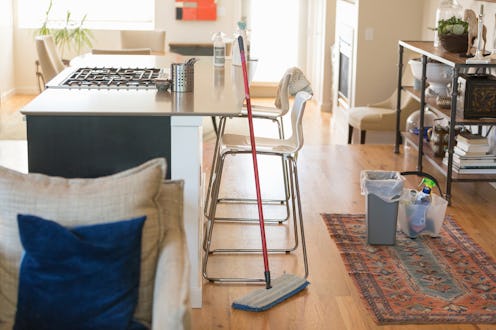Never in my life have I felt so passionate about keeping my home clean. I'm already an organized person, but these days I've found myself diving into deep, dark rabbit holes of information to learn how to actually kill germs on every surface, from my metal door handles to my kitchen's quartz countertops. While most of the info I've gleaned isn't totally surprising, one fact did stick out: Cleaning, sanitizing, and disinfecting all have completely different definitions.
According to the Centers for Disease Control and Prevention, "cleaning" refers to removing germs from an object, "disinfecting" means killing germs, and "sanitizing" refers to lowering the number of germs on an object to a safe level. Each of these methods has its own way of making your home a safer place, but the distinction is still an important one to know — especially as you're shopping for home cleaning products.
Assuming your goal is as simple as making your home safer for yourself and your loved ones, read on to learn the most effective ways to tackle high-traffic surfaces. The best part? You can probably use whatever products you already have safely stashed under your kitchen sink, meaning there's no need to venture out to your neighborhood store. Here's what you need to know:
In The Bathroom
For a room dedicated to getting ourselves clean, I'm always amazed at just how quickly my bathroom gets messy. To rid your shower area, toilet, and even your bathroom countertops of germs, look for a bathroom cleaner that also has some disinfecting power. A product like Microban 24 Bathroom Cleaner kills 99.9% of bacteria* on your surfaces and continues killing bacteria for a full 24 hours**. Plus it destroys soap scum and prevents the growth of mold and mildew+ for 7 days*. Not to mention, this particular cleaner can also help reduce odors, which — for a bathroom? — makes this product feel like a gift from above.
For The Kitchen
Ever wonder why there are different cleaners for bathroom surfaces and kitchen surfaces? It's because the formulas are not only created to deal with different types of grime (soap scum and food splatters are two totally different beasts), but also because you need to be extra thoughtful when choosing a cleaning method for your food-prep surfaces, since many antibacterial products aren't approved for standard use on surfaces that come in contact with your food.
Cleaning these surfaces is fairly self-explanatory: All you need to do is grab your preferred surface cleaner and a clean towel, then go to town to remove dirt, grease, and grime. (Just remember to check the label instructions on antibacterial products, since a clean water rinse may be required after use.)
If you're hoping to kill anything that may still be lingering on the surface, the current recommendation is to use a diluted mixture of your standard household bleach. If your surface is bleach-safe (double-check with your manufacturer if you're not sure), mix four teaspoons of bleach and one quart of water. Spray the mixture directly onto the surface and allow it to stand for at least one minute. Once the surface has air-dried, rinse with water and wipe with a clean towel, then consider that countertop disinfected.
For Pesky Electronics
Like (I'm assuming) most people, I'm secretly guilty of rarely cleaning my electronics out of fear of accidentally frying them. But I know that even the cloudiest of smartphones screens deserve their chance to shine, so I've found the disinfecting solution we all need.
First, definitely check for your manufacturer's instructions for cleaning and disinfecting, and follow those as you're able. If you're in a pinch, the CDC recommends using an alcohol-based wipe containing at least 70% alcohol. Ensure the wipe isn't dripping any liquid, then use it to carefully clean the high-touch surface. Allow it to air-dry, et voilà: a considerably less-germy device.
*When used as directed
**Effective against S. aureus and E. Aerogenes
+Effective against Aspergillus niger
This post is sponsored by Microban 24.
